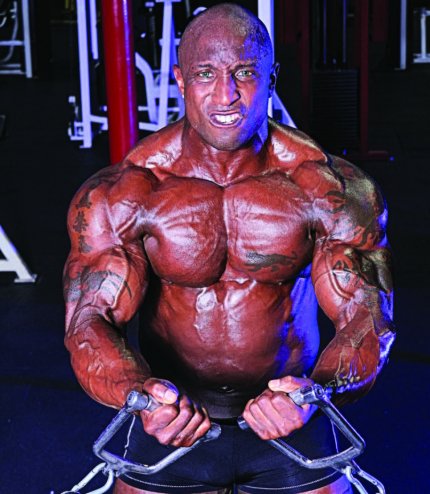The Hardgainers Guide To Size

Training for Muscle & Might. The Four-Fold Plan For Hardgainers.
I’ve written over 500 training articles for hardgainers, for 15 years I published a magazine for hardgainers, and I’ve written five books for hardgainers. Here are four facts for hardgainers, followed by a plan for success »
- You don’t have to apply the foolish “no pain, no gain” maxim.
- You don’t have to train four, five, or six times a week.
- You don’t have to use high-volume training.
- You don’t have to use steroids.
There’s a Much Better Way »
1. UNDERSTAND THE GENETIC COMPONENT
Know-how and dedication are essential for bodybuilding success, but how far you can go, at what pace, and what form the results will take, are hugely affected by your genetics.
As far as bodybuilding goes, the phenomenally gifted are less than 1% of the training population. They have a blend of body structure, muscle insertion points, muscle belly length, muscle fiber type and number, tendency for leanness, recuperative powers, and resistance to injury that gives them TREMENDOUSLY responsive bodies with the potential for muscular development far in excess of that of the typical person. They’re super easygainers, with the potential to be big-name bodybuilders. They can prosper on routines that are useless for hardgainers. Therefore, FORGET about how steroid-enhanced, genetically gifted bodybuilders train.
Even if you stuff yourself with bodybuilding drugs, if you don’t have the freaky genetics required for superstar bodybuilding success, you’ll still NEVER become a superstar. But you’d probably ruin your health from the drug abuse.
Almost all bodybuilders are hardgainers, although some are harder gainers than others. But because most hardgainers train like these drug-infused supermen, they will always struggle. They may even become NOGAINERS.
2. TRAINING
To impose sufficient demands on your body to stimulate muscular growth, you MUST train hard. It’s MUCH easier to train hard when you train briefly, because you don’t have many exercises to spread your efforts over. Also, short-duration routines are less likely to exceed your limited recuperative abilities than longer routines. But
most hardgainers employ too many exercises, too lengthy workouts, and too many workouts.
But even with short routines, if you train too often, you’ll still get nowhere. For the next few months, train just twice a week and alternate two different full-body routines. Here’s an example of a proven effective program for hardgainers:
DAY 1
| EXERCISE | SETS | REPS |
|---|---|---|
| Squats (w) | 2 | 8 |
| Standing Calf Raises (w) | 2 | 10 |
| Leg Curls (w) | 2 | 8 |
| Bench Presses (w) | 2 | 6 |
| Pulldowns (w) | 2 | 6 |
| Seated Overhead Dumbbell Presses (w) | 2 | 6 |
| Incline Dumbbell Curls (w) | 2 | 6 |
| Crunches | 2 | 10 |
DAY 2
| EXERCISE | SETS | REPS |
|---|---|---|
| (A) Squats (w) | 1 | 20 |
| (B) Straight-Arm Pullovers | 1 | 15 |
| Standing Calf Raises (w) | 2 | 15 |
| Stiff-legged Deadlifts from two inches below knee height (w) | 2 | 6 |
| Parallel Bar Dips (w) | 2 | 6 |
| Seated Row with torso supported (w) | 2 | 6 |
| Dumbbell or Machine Shrugs (w) | 2 | 8 |
| Standing Hammer Curls (w) | 2 | 8 |
| Side Bends (w) | 1 | 10 |
EXERCISE & TRAINING PROTOCOLS
PROVIDED you’re suited to the barbell squat and perform it correctly, it’s a BRILLI ANT exercise. But if you’re not suited to it – typically because you have long legs relative to your torso – substitute the parallel-grip deadlift, using the trap bar or (preferably) the shrug bar. Another alternative is the leg press, but I consider the parallel-grip deadlift a superior exercise to the leg press.
To do the stiff-legged deadlift from just below knee height, set up the pins in a power rack two inches below your knees, or elevate the loaded barbell on sturdy platforms to the appropriate height.
At your second workout each week, do the 20-rep squat. When done in the context of brief workouts and with lots of recuperation time and sufficient nutrition, 20-rep squats are SUPER EFFECTIVE. Just be sure to work into them GRADUALLY. If you jump into using your best poundage for 20 reps, you may find it so tough that you burn yourself out too soon before the exercise can do you any good. In order to prevent this, warm up properly and then use half the weight you used for the squats in the Day 1 workout. That should enable you to make your 20 reps comfortably.
Additionally for the 20-rep squats, don’t do them continuously. Do a rep and then as you stand between reps, take two or three deep breaths before the next rep and so on. For the final five reps, take four or five deep breaths between reps if you need them.
Immediately after the 20-rep squats, rush to a bench and do a set of 15 straight-arm pullovers with no more than 15 pounds. Use a short bar, dumbbell, or barbell plate and focus on deep breathing. Inhale deeply on the descent and exhale on the ascent. Over a few months, especially if you’re a teenager or in your early twenties, the breathing pullover may enlarge your rib cage. It’s a traditional accompaniment to the 20-rep squat.
Each week add five pounds to your 20-rep squat. To begin with, the 20-rep squat will be leisurely. But once the poundage has been built up sufficiently, which may not be for over two months, both of your weekly squat sessions will be musclebuilding ones.
TEMPO
Use a controlled rep speed. Take two to three seconds for the positive phase of each rep and a further two to three seconds for the negative phase of each rep. Pause for a second or so between reps.
REST PERIODS
Don’t rush between sets. Take two to three minutes between sets of the small exercises, such as the curl, and three to four minutes between sets of the big exercises, such as the bench press.
LOAD
Before you start this new program, take a week’s layoff to get fully rested. Start the program with comfortable weights. Add weight (e.g. five pounds) to every exercise each workout and take four weeks before you start to handle your current maximum weights for the target sets and reps. THEN train hard until you read my next column in this magazine for the changes to make.
Once you’re training hard and lifting heavy, you’ll reach a point where you can’t add five or more pounds at a time to an exercise and still perform the indicated number of reps. In this case, just add one or two pounds at a time. Find some small weight plates or large washers, or use multiple pairs of spring collars.
CARDIO
Never mind cardio for the time being. Make bodybuilding your only demanding athletic activity.

3. NUTRITION
In my teens I ate three big meals, two or three snacks each day, and included up to a gallon of milk a day. You may not need to consume that much depending on your age, size, and activity level, but if you short change yourself on nutrition, you’ll undermine, if not nullify, the good work you do in the gym.
Without intensive, progressive training, any calories beyond what you need to maintain your bodyweight will be stored as fat. WITH intensive, progressive training, excess calories are NEEDED for muscle growth to occur. But a sustained, overly excessive caloric intake will produce a lot of body fat no matter how hard your training may be.
Once you’re training hard, eat as much as you can WITHOUT gaining any noticeable body fat. GRADUALLY add a little more food every few days until you reach the point where your waist increases. Then back off a little so that your waist size stays constant and settle at that intake. Visit www.CalorieKing.com and compute your average daily intake. Monitor your waist girth to keep tabs on your body fat level. You want muscle gains, not fat gains. But don’t try to stay ripped, or get ripped while trying to build bigger muscles.
You need protein (a gram per pound of bodyweight should be enough), carbs, AND fats. A low-fat diet will undermine, if not kill, your efforts to build bigger muscles. Make your fat sources healthy and don’t fry anything. Your daily fat intake should include two teaspoonfuls each of flaxseed, cod liver and extra virgin olive oils. Drink enough water so that you’re never anything other than SLIGHTLY thirsty.
If you’re in your early twenties, already eat a lot and yet are skinny, you temporarily have very high caloric needs. If you can’t consume enough calories through solid food, have a potent shake twice a day between main meals. During periods of high caloric intake, it’s easier to consume some of it through nutritious drinks than get it all through solid food. But find shake concoctions that are easy on your digestion. If you can’t digest milk, use a milk substitute and a protein powder you can digest easily. But before you buy a large
quantity of one brand, test a small quantity.
Take a potent multivitamin and mineral tablet each day and additional vitamin C.
4. REST AND SLEEP
Get AT LE AST eight hours of quality sleep each night. Adequate sleep isn’t just important for recovery between workouts. In order to feel enthusiastic for training, you need to be well rested. If you shortchange yourself of sleep, you’ll hamper your bodybuilding progress.
IN CONCLUSION
Train correctly at every workout. Eat correctly at every meal. Sleep well every night. Do all of that RELEN TLESSLY . Then you’ll make steady bodybuilding progress.
Stuart McRobert has over 30 years of bodybuilding experience, has had over 500 articles published, and is the author of five books on bodybuilding. For information on his books, please visit: www.hardgainer.com.


